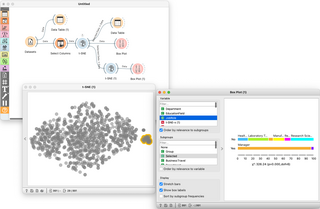Natural language processing (NLP) is an interdisciplinary subfield of computer science and linguistics. It is primarily concerned with giving computers the ability to support and manipulate human language. It involves processing natural language datasets, such as text corpora or speech corpora, using either rule-based or probabilistic machine learning approaches. The goal is a computer capable of "understanding" the contents of documents, including the contextual nuances of the language within them. The technology can then accurately extract information and insights contained in the documents as well as categorize and organize the documents themselves.

Orange is an open-source data visualization, machine learning and data mining toolkit. It features a visual programming front-end for explorative qualitative data analysis and interactive data visualization.

Waikato Environment for Knowledge Analysis (Weka) is a collection of machine learning and data analysis free software licensed under the GNU General Public License. It was developed at the University of Waikato, New Zealand and is the companion software to the book "Data Mining: Practical Machine Learning Tools and Techniques".

Distributional semantics is a research area that develops and studies theories and methods for quantifying and categorizing semantic similarities between linguistic items based on their distributional properties in large samples of language data. The basic idea of distributional semantics can be summed up in the so-called distributional hypothesis: linguistic items with similar distributions have similar meanings.
The following outline is provided as an overview of and topical guide to natural-language processing:
Eclipse Deeplearning4j is a programming library written in Java for the Java virtual machine (JVM). It is a framework with wide support for deep learning algorithms. Deeplearning4j includes implementations of the restricted Boltzmann machine, deep belief net, deep autoencoder, stacked denoising autoencoder and recursive neural tensor network, word2vec, doc2vec, and GloVe. These algorithms all include distributed parallel versions that integrate with Apache Hadoop and Spark.
In natural language processing (NLP), a word embedding is a representation of a word. The embedding is used in text analysis. Typically, the representation is a real-valued vector that encodes the meaning of the word in such a way that the words that are closer in the vector space are expected to be similar in meaning. Word embeddings can be obtained using language modeling and feature learning techniques, where words or phrases from the vocabulary are mapped to vectors of real numbers.
Word2vec is a technique in natural language processing (NLP) for obtaining vector representations of words. These vectors capture information about the meaning of the word and their usage in context. The word2vec algorithm estimates these representations by modeling text in a large corpus. Once trained, such a model can detect synonymous words or suggest additional words for a partial sentence. As the name implies, word2vec represents each distinct word with a particular list of numbers called a vector. The vectors are chosen carefully such that they capture the semantic and syntactic qualities of words; as such, a simple mathematical function can indicate the level of semantic similarity between the words represented by those vectors.
Apache SystemDS is an open source ML system for the end-to-end data science lifecycle.
GloVe, coined from Global Vectors, is a model for distributed word representation. The model is an unsupervised learning algorithm for obtaining vector representations for words. This is achieved by mapping words into a meaningful space where the distance between words is related to semantic similarity. Training is performed on aggregated global word-word co-occurrence statistics from a corpus, and the resulting representations showcase interesting linear substructures of the word vector space. It is developed as an open-source project at Stanford and was launched in 2014. As log-bilinear regression model for unsupervised learning of word representations, it combines the features of two model families, namely the global matrix factorization and local context window methods.
The following outline is provided as an overview of and topical guide to machine learning:
A latent space, also known as a latent feature space or embedding space, is an embedding of a set of items within a manifold in which items resembling each other are positioned closer to one another. Position within the latent space can be viewed as being defined by a set of latent variables that emerge from the resemblances from the objects.



